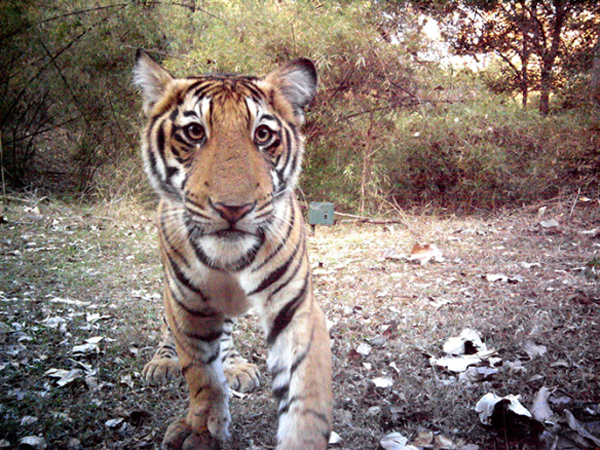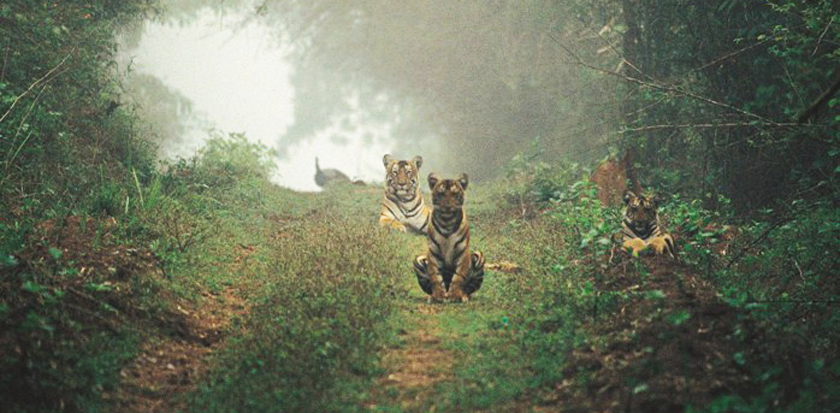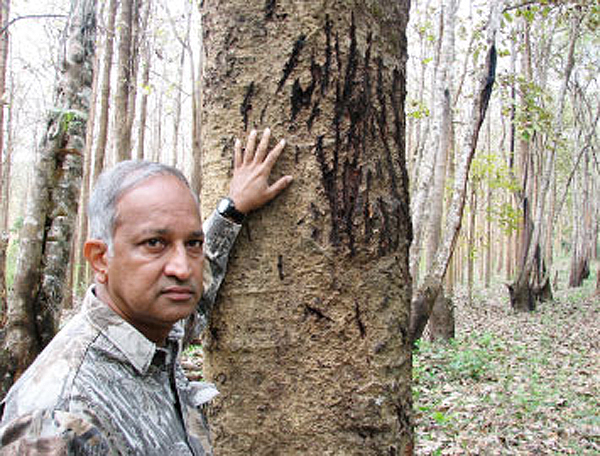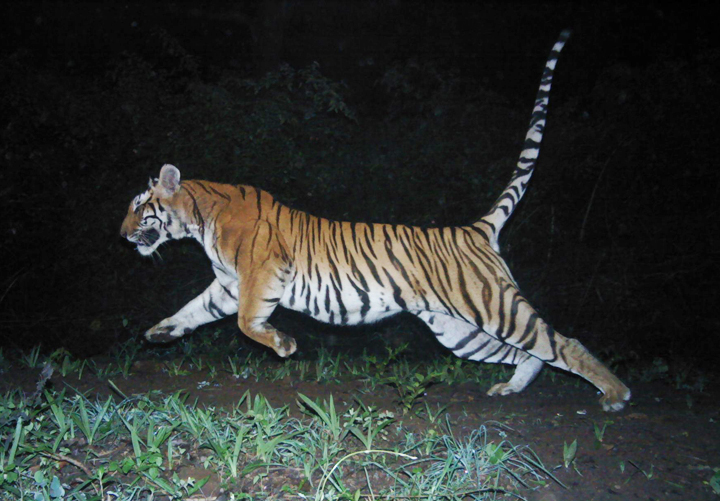What’s Got The King Of Counting Tigers Growling?
There’s great hope for tigers in India, but miscalculated census numbers don’t help, says revered big cat expert Ullas Karanth.
By Vicki Croke
A healthy tiger cub triggering a camera trap embodies the future of the big cats in India “If you can expand this strictly protected area,†Dr. Karanth says, “potentially we could have 5,000 or 10,000 tigers in India, no problem.†Photo: Ullas Karanth/WCS.
Believe it or not, there’s a right way and a wrong way to count tigers.
So when India announced recently that it’s most recent tiger survey revealed that the endangered big cats had increased by a whopping 30 percent to 2,226, Ullas Karanth, one of the most revered tiger experts in the world didn’t disagree with the enthusiasm or optimism over the future of the country’s iconic cat.
But he did disagree with the numbers. And that’s not just a quibble. It’s a belief that a miscalculation over how many tigers there are, and, just as important, where exactly they live, could botch the chances for what can be a population in ascendance.
WCS’s Ullas Karanth has spent a life among tigers. Photo: Julie Larson/WCS.
In the wake of that much reported study, we sat down with the man who—in part through the use of camera trapping—revolutionized tiger censusing back in 1991 and is now the Wildlife Conservation Society’s director of science for Asia. We asked him what’s at stake, how the population can be adequately quantified, and how he views the future of tigers in general.
“In the same places where there were less than 50 to 60 tigers, now I put my cameras and I get 400 tigers—they have come back.â€
The good news is that this very sober scientist does believe in miracles. Especially where tigers are concerned, because he’s seen a tiger miracle take place once already in India. He grew up in southern India, in the very area where he now conducts his tiger research. But back when he was a boy, the forests were pretty empty.
“This was the Malenad Landscape where I now do my research,†Dr. Karanth explains. “At that time, it was just being laid waste—in the late 1950s, early 1960s. Forests were being cleared. Tigers were being shot. There was not protection. No laws to protect tigers, so I thought, ‘it will all go.’ I wandered in all the forests. I saw very little wildlife and so it was with a sense of desperation that I thought, ‘I must see all this wildlife before it vanishes.’†But it didn’t vanish. Karanth says, “In the same places where there were less than 50 to 60 tigers, now I put my cameras and I get 400 tigers—they have come back.â€
By closely monitoring tigers, especially where they are thriving, their population might just bloom. Photo: Ullas Karanth/WCS.
The comeback hasn’t been easy, but starting in the 1970s, a serious campaign to save India’s forests and wildlife began. And it continues. Today, India spends more money on tiger conservation than any other country, according to the Associated Press. But conservation isn’t a war you win once. And Dr. Karanth’s latest battle concerns how tigers are audited.
He compares the tiger population to a patient in intensive care who needs constant monitoring.
Most of the world’s wild tiger population lives in India. And if we zoom in on the picture, we see that 90 percent of India’s tigers live in just 10 percent of tiger habitat—in certain tiger hot spots where there are great concentrations of the big cats. Like that patient in intensive care, Dr. Karanth believes that the safety and health of these key populations must be checked once a year, so that problems can be addressed before they become critical.
Under the current system, the government conducts an expensive, nation-wide, and Karanth believes, inaccurate, census every four years.
The veteran conservationist is campaigning for a different kind of census to be conducted on a two-tier timetable: By checking the tiger hot spots once a year—while continuing the larger census (but with a more accurate methodology) every four years, the tigers can be saved.
Ullas Karanth (standing by a tree raked by tiger claws), says he doesn’t fear the jungle. Just as urbanites use traffic signals and crosswalks to avoid being run over, Karanth says the forest provides warnings too: “If you know all the rules, I think you’re pretty safe in the jungle.” Photo: Ullas Karanth/WCS.
“So, what I’m recommending is that you focus on counting that 90 percent using the best methodologies every year because populations could get wiped out in a year, or populations could come back big time,†he says. “Then, once every four or five years, look across the country—not how many there are, that’s not easy at that scale, so you say: Where are the tigers?†Is the range expanding? Is it collapsing? “That’s a question you can answer at the larger scale.â€
By closely monitoring tigers, especially where they are thriving, their population might just bloom. If you know where the tiger hot spots are, you can enlarge them.
“If you can expand this strictly protected area,†Dr. Karanth says, “potentially we could have 5,000 or 10,000 tigers in India, no problem.â€
History has shown, Karanth says, that we can’t give adequate help to tigers if we don’t understand where their numbers are expanding and where they’re contracting. Tiger censuses, using “pugmarks,†or tiger footprints, began under Indira Gandhi’s government in the early 1970s. The method was unreliable and led to some outrageously bad reporting. For instance, a couple of tigerless reserves claimed to have large numbers of the cats.
Camera trap shot of a tiger on the move at night. Photo: Ullas Karanth/WCS.
The method was finally replaced, but the newer one, Karanth says, is even worse, with many poorly-trained observers whose data was analyzed using a poor statistical model. Dr. Karanth says the method “is generating answers that don’t make sense.â€
According to Katy Daigle of the Associated Press:
When India says it now is home to 2,226 tigers, what it is giving is an estimate — a best-guess based on a technique called index-calibration that combines small-scale cat counts and, through complex calculations, extrapolates them to a national total. Those counts are conducted by various groups — forest rangers, independent scientists, tiger charities — through various means, including photographing individual tigers and analyzing tiger droppings and paw prints.
The technique, which India adopted in 2006, is by no means perfect. An Oxford-led study published in February by the journal Methods in Ecology and Evolution suggested the data collection was too erratic for adequately predicting cat populations in areas outside census monitoring.
Scientists also question the absence of independent oversight in the government-organized census. And some say that one census every four years is not enough.
Karanth was part of that Oxford-led study, and he is among those who drew the wrath of the census takers. Some of them called the criticism “rubbish,†and some called for the paper to be withdrawn from the journal. Dr. Karanth shakes his head and smiles when thinking of that. “This is like the time of the pope and Galileo,†he says. “It’s nonsense!â€
It’s not just the way the numbers are crunched that bothers Dr. Karanth. He feels that the work of counting is in the wrong hands. There may be an inherent conflict in asking the people whose job it is to keep tigers safe to measure if tigers have been kept safe. Forest officials have in many cases, risked their lives to help tigers, and Dr. Karanth expresses great respect for them. But he’d like to see the counting done by unbiased and specially trained census takers—many of whom can be found in the wildlife biology departments of the country’s universities.
Karanth is a pragmatist, and he doesn’t just have ideas about how to fix things, he’s got a working model.
In Malenad, that tiger-rich area in southern India, which contains 20 percent of the country’s tigers, Karanth and WCS have devised what he believes to be a winning combination of camera-trap counting and effective statistical protocols to provide consistent and frequent portraits of the tiger population, their prey, and the health of the habitat they live in.
Because of those tiger hot spots, the areas where big numbers of the cats are concentrated, Karanth argues that the Malenad method has the potential to accomplish up-to-date tracking on 90 percent of India’s tigers.
Tigers captured on film in Nagarhole National Park in India. Photo: Ullas Karanth/WCS.
He says, “I think we have a reasonably good chance—if we are smart—to actually increase numbers. There’s no doubt that what I feared did not come true. Things changed for the better after the 1970s. And I think if we manage what we have sensibly we could have far more tigers.â€
It’s a dearly-held goal for a man who has spent his life in the forest walking fearlessly, but respectfully among these beautiful predators, getting to know them not just as a species, but as individuals.
One of his favorite cats was a female he followed for six years, spending all week in the forest and coming home on weekends. “My wife use to joke, saying that ‘you spend more time with this tigress than with me!’â€






